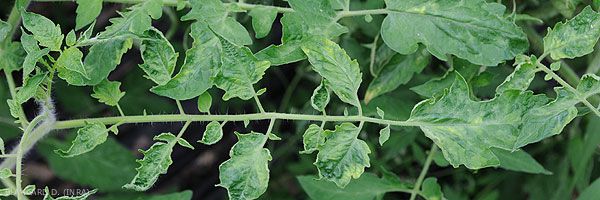
Tobacco mosaic virus
(TMV)
Tobacco mosaic virus
,
- classification: Tobamovirus, not classified in a family
The tobacco mosaic virus ( Tobacco mosaic virus , TMV), present in all the production areas where susceptible varieties are grown tobacco appears on tomato in many countries. It should be noted that for a long time, TMV has been associated with infections due in fact to ToMV, a virus that is similar and much more competitive on tomatoes. Therefore, there is often a doubt when consulting the bibliography on the real identity of the virus described, and on the characteristics associated with it.
In France, the cultivation of varieties resistant to TMV and ToMV is probably at the origin of its virtual disappearance of tobacco and tomato crops. It is only found very occasionally, on sensitive varieties of tobacco (Burley or Virginia types), chilli and tomato. Because of its persistence in France, it still constitutes a threat which should encourage breeders to continue to take it into account in selection programs for tomatoes, chili peppers and tobacco.
This virus is still serious in countries where resistant varieties are little used. In industrialized countries, its importance is only sporadic.
TMV is responsible for tobacco mosaic disease, the first observed and reported virus disease. This disease was first reported on tobacco in the Netherlands as early as 1886, and in Russia in 1892. TMV was retained as the type species of the genus Tobamovirus (Figure 1); it is a model virus on which many fundamental studies have been carried out, especially at the molecular level.
 |
| Figure 1 |
Several strains have been reported: U1 in the United States, SP1 and aucuba (Tmj ) in France, KMS (Kassanis) If we are interested in the virulence of these strains, the U1, SP1 and KMS strains would be of pathotype 0. On the other hand, the Tmj strain, which overcomes the “ gene Tm-1 ” , would be of pathotype 1 (see also chapter Protection on the ToMV ).
The virions have the shape of rigid rods, measuring 300 x 15 nm.





